Safety and Risk Management in Industries
VerifiedAdded on 2020/03/01
|16
|4300
|21
AI Summary
This assignment delves into the critical field of safety and risk management within diverse industrial sectors. It examines established safety protocols, regulations, and best practices employed to mitigate hazards and ensure worker well-being. The document analyzes various case studies highlighting real-world applications of safety management systems. Additionally, it explores the role of technology, training, and organizational culture in fostering a safe work environment. The assignment emphasizes the importance of proactive risk assessment and mitigation strategies for minimizing accidents and promoting sustainable operations across industries.
Contribute Materials
Your contribution can guide someone’s learning journey. Share your
documents today.
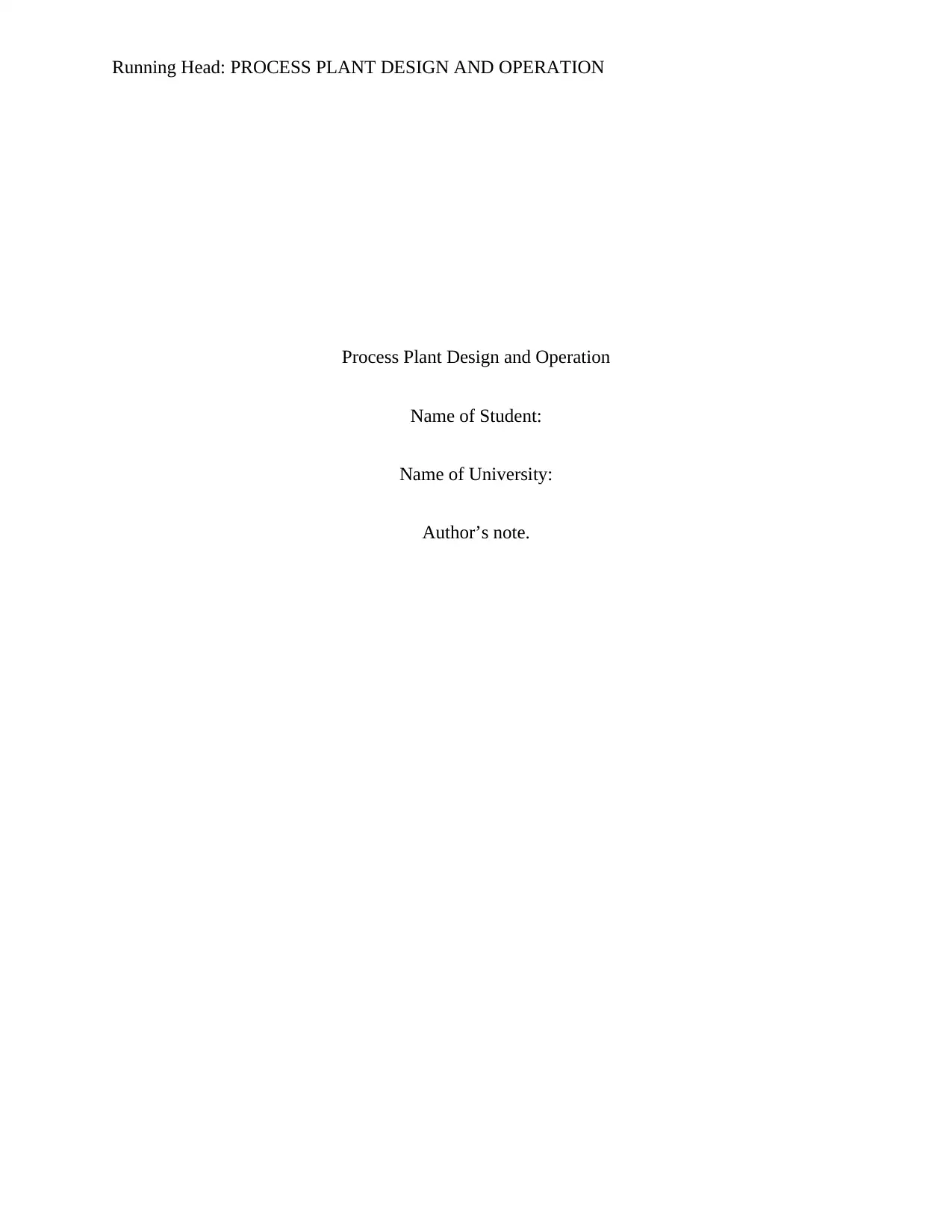
Running Head: PROCESS PLANT DESIGN AND OPERATION
Process Plant Design and Operation
Name of Student:
Name of University:
Author’s note.
Process Plant Design and Operation
Name of Student:
Name of University:
Author’s note.
Secure Best Marks with AI Grader
Need help grading? Try our AI Grader for instant feedback on your assignments.
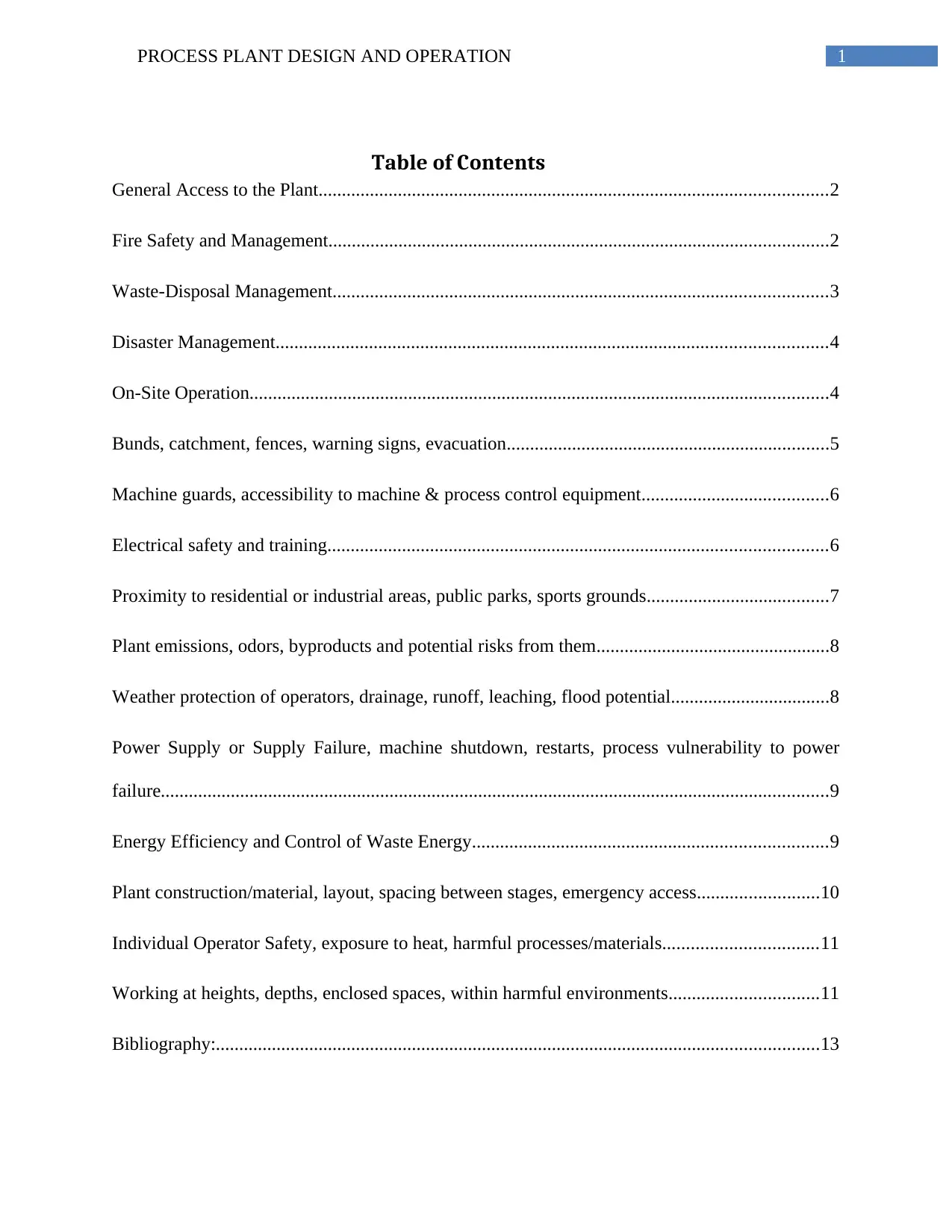
1PROCESS PLANT DESIGN AND OPERATION
Table of Contents
General Access to the Plant.............................................................................................................2
Fire Safety and Management...........................................................................................................2
Waste-Disposal Management..........................................................................................................3
Disaster Management......................................................................................................................4
On-Site Operation............................................................................................................................4
Bunds, catchment, fences, warning signs, evacuation.....................................................................5
Machine guards, accessibility to machine & process control equipment........................................6
Electrical safety and training...........................................................................................................6
Proximity to residential or industrial areas, public parks, sports grounds.......................................7
Plant emissions, odors, byproducts and potential risks from them..................................................8
Weather protection of operators, drainage, runoff, leaching, flood potential..................................8
Power Supply or Supply Failure, machine shutdown, restarts, process vulnerability to power
failure...............................................................................................................................................9
Energy Efficiency and Control of Waste Energy............................................................................9
Plant construction/material, layout, spacing between stages, emergency access..........................10
Individual Operator Safety, exposure to heat, harmful processes/materials.................................11
Working at heights, depths, enclosed spaces, within harmful environments................................11
Bibliography:.................................................................................................................................13
Table of Contents
General Access to the Plant.............................................................................................................2
Fire Safety and Management...........................................................................................................2
Waste-Disposal Management..........................................................................................................3
Disaster Management......................................................................................................................4
On-Site Operation............................................................................................................................4
Bunds, catchment, fences, warning signs, evacuation.....................................................................5
Machine guards, accessibility to machine & process control equipment........................................6
Electrical safety and training...........................................................................................................6
Proximity to residential or industrial areas, public parks, sports grounds.......................................7
Plant emissions, odors, byproducts and potential risks from them..................................................8
Weather protection of operators, drainage, runoff, leaching, flood potential..................................8
Power Supply or Supply Failure, machine shutdown, restarts, process vulnerability to power
failure...............................................................................................................................................9
Energy Efficiency and Control of Waste Energy............................................................................9
Plant construction/material, layout, spacing between stages, emergency access..........................10
Individual Operator Safety, exposure to heat, harmful processes/materials.................................11
Working at heights, depths, enclosed spaces, within harmful environments................................11
Bibliography:.................................................................................................................................13
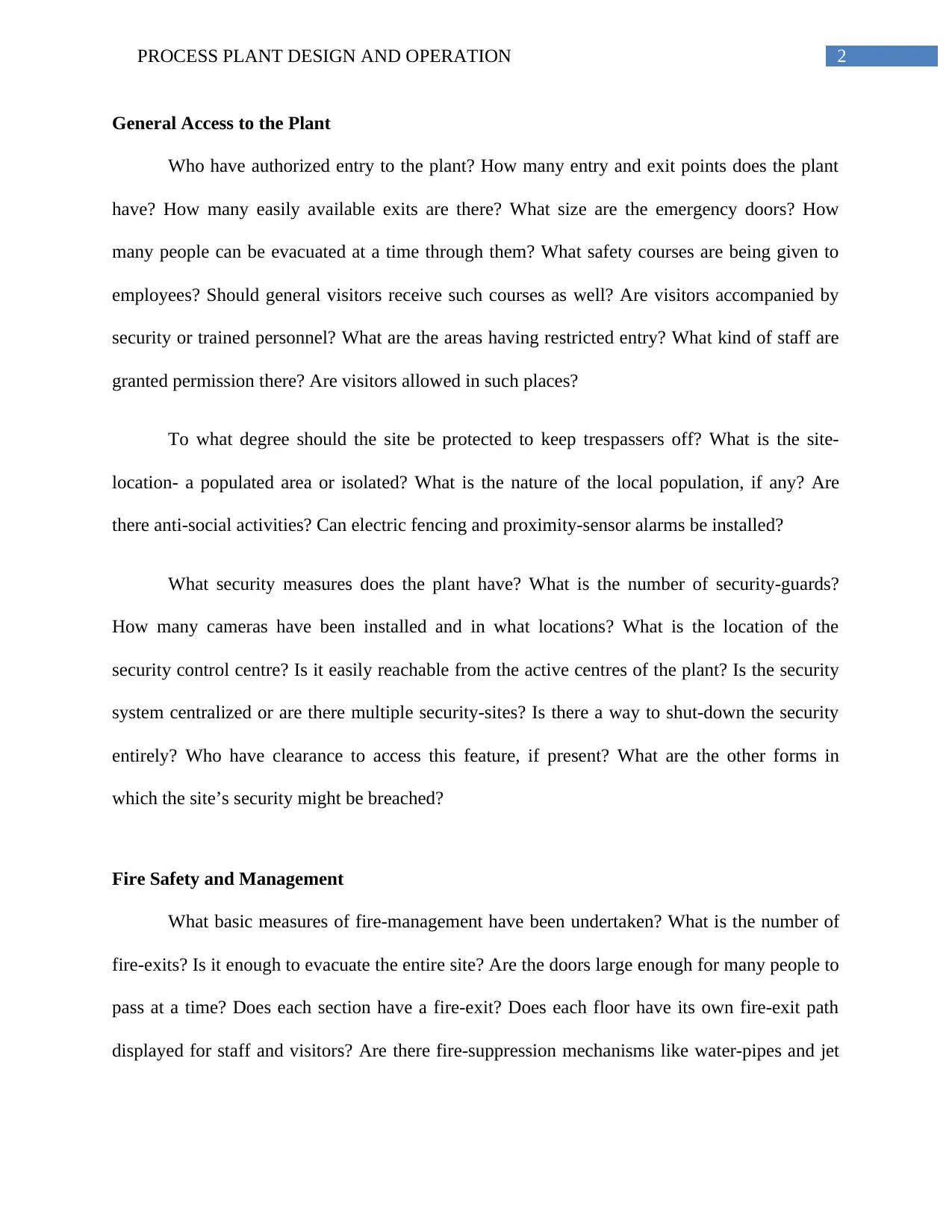
2PROCESS PLANT DESIGN AND OPERATION
General Access to the Plant
Who have authorized entry to the plant? How many entry and exit points does the plant
have? How many easily available exits are there? What size are the emergency doors? How
many people can be evacuated at a time through them? What safety courses are being given to
employees? Should general visitors receive such courses as well? Are visitors accompanied by
security or trained personnel? What are the areas having restricted entry? What kind of staff are
granted permission there? Are visitors allowed in such places?
To what degree should the site be protected to keep trespassers off? What is the site-
location- a populated area or isolated? What is the nature of the local population, if any? Are
there anti-social activities? Can electric fencing and proximity-sensor alarms be installed?
What security measures does the plant have? What is the number of security-guards?
How many cameras have been installed and in what locations? What is the location of the
security control centre? Is it easily reachable from the active centres of the plant? Is the security
system centralized or are there multiple security-sites? Is there a way to shut-down the security
entirely? Who have clearance to access this feature, if present? What are the other forms in
which the site’s security might be breached?
Fire Safety and Management
What basic measures of fire-management have been undertaken? What is the number of
fire-exits? Is it enough to evacuate the entire site? Are the doors large enough for many people to
pass at a time? Does each section have a fire-exit? Does each floor have its own fire-exit path
displayed for staff and visitors? Are there fire-suppression mechanisms like water-pipes and jet
General Access to the Plant
Who have authorized entry to the plant? How many entry and exit points does the plant
have? How many easily available exits are there? What size are the emergency doors? How
many people can be evacuated at a time through them? What safety courses are being given to
employees? Should general visitors receive such courses as well? Are visitors accompanied by
security or trained personnel? What are the areas having restricted entry? What kind of staff are
granted permission there? Are visitors allowed in such places?
To what degree should the site be protected to keep trespassers off? What is the site-
location- a populated area or isolated? What is the nature of the local population, if any? Are
there anti-social activities? Can electric fencing and proximity-sensor alarms be installed?
What security measures does the plant have? What is the number of security-guards?
How many cameras have been installed and in what locations? What is the location of the
security control centre? Is it easily reachable from the active centres of the plant? Is the security
system centralized or are there multiple security-sites? Is there a way to shut-down the security
entirely? Who have clearance to access this feature, if present? What are the other forms in
which the site’s security might be breached?
Fire Safety and Management
What basic measures of fire-management have been undertaken? What is the number of
fire-exits? Is it enough to evacuate the entire site? Are the doors large enough for many people to
pass at a time? Does each section have a fire-exit? Does each floor have its own fire-exit path
displayed for staff and visitors? Are there fire-suppression mechanisms like water-pipes and jet
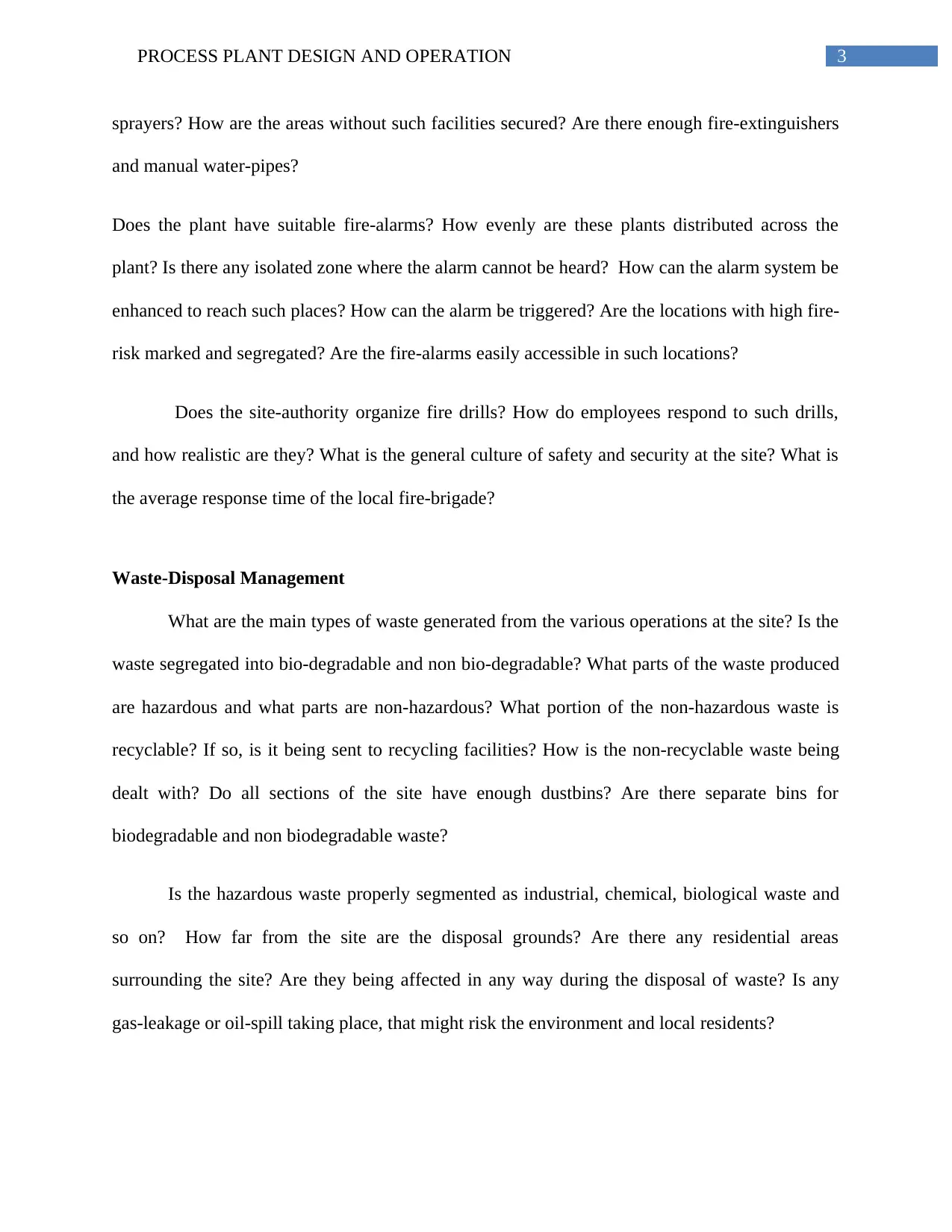
3PROCESS PLANT DESIGN AND OPERATION
sprayers? How are the areas without such facilities secured? Are there enough fire-extinguishers
and manual water-pipes?
Does the plant have suitable fire-alarms? How evenly are these plants distributed across the
plant? Is there any isolated zone where the alarm cannot be heard? How can the alarm system be
enhanced to reach such places? How can the alarm be triggered? Are the locations with high fire-
risk marked and segregated? Are the fire-alarms easily accessible in such locations?
Does the site-authority organize fire drills? How do employees respond to such drills,
and how realistic are they? What is the general culture of safety and security at the site? What is
the average response time of the local fire-brigade?
Waste-Disposal Management
What are the main types of waste generated from the various operations at the site? Is the
waste segregated into bio-degradable and non bio-degradable? What parts of the waste produced
are hazardous and what parts are non-hazardous? What portion of the non-hazardous waste is
recyclable? If so, is it being sent to recycling facilities? How is the non-recyclable waste being
dealt with? Do all sections of the site have enough dustbins? Are there separate bins for
biodegradable and non biodegradable waste?
Is the hazardous waste properly segmented as industrial, chemical, biological waste and
so on? How far from the site are the disposal grounds? Are there any residential areas
surrounding the site? Are they being affected in any way during the disposal of waste? Is any
gas-leakage or oil-spill taking place, that might risk the environment and local residents?
sprayers? How are the areas without such facilities secured? Are there enough fire-extinguishers
and manual water-pipes?
Does the plant have suitable fire-alarms? How evenly are these plants distributed across the
plant? Is there any isolated zone where the alarm cannot be heard? How can the alarm system be
enhanced to reach such places? How can the alarm be triggered? Are the locations with high fire-
risk marked and segregated? Are the fire-alarms easily accessible in such locations?
Does the site-authority organize fire drills? How do employees respond to such drills,
and how realistic are they? What is the general culture of safety and security at the site? What is
the average response time of the local fire-brigade?
Waste-Disposal Management
What are the main types of waste generated from the various operations at the site? Is the
waste segregated into bio-degradable and non bio-degradable? What parts of the waste produced
are hazardous and what parts are non-hazardous? What portion of the non-hazardous waste is
recyclable? If so, is it being sent to recycling facilities? How is the non-recyclable waste being
dealt with? Do all sections of the site have enough dustbins? Are there separate bins for
biodegradable and non biodegradable waste?
Is the hazardous waste properly segmented as industrial, chemical, biological waste and
so on? How far from the site are the disposal grounds? Are there any residential areas
surrounding the site? Are they being affected in any way during the disposal of waste? Is any
gas-leakage or oil-spill taking place, that might risk the environment and local residents?
Secure Best Marks with AI Grader
Need help grading? Try our AI Grader for instant feedback on your assignments.
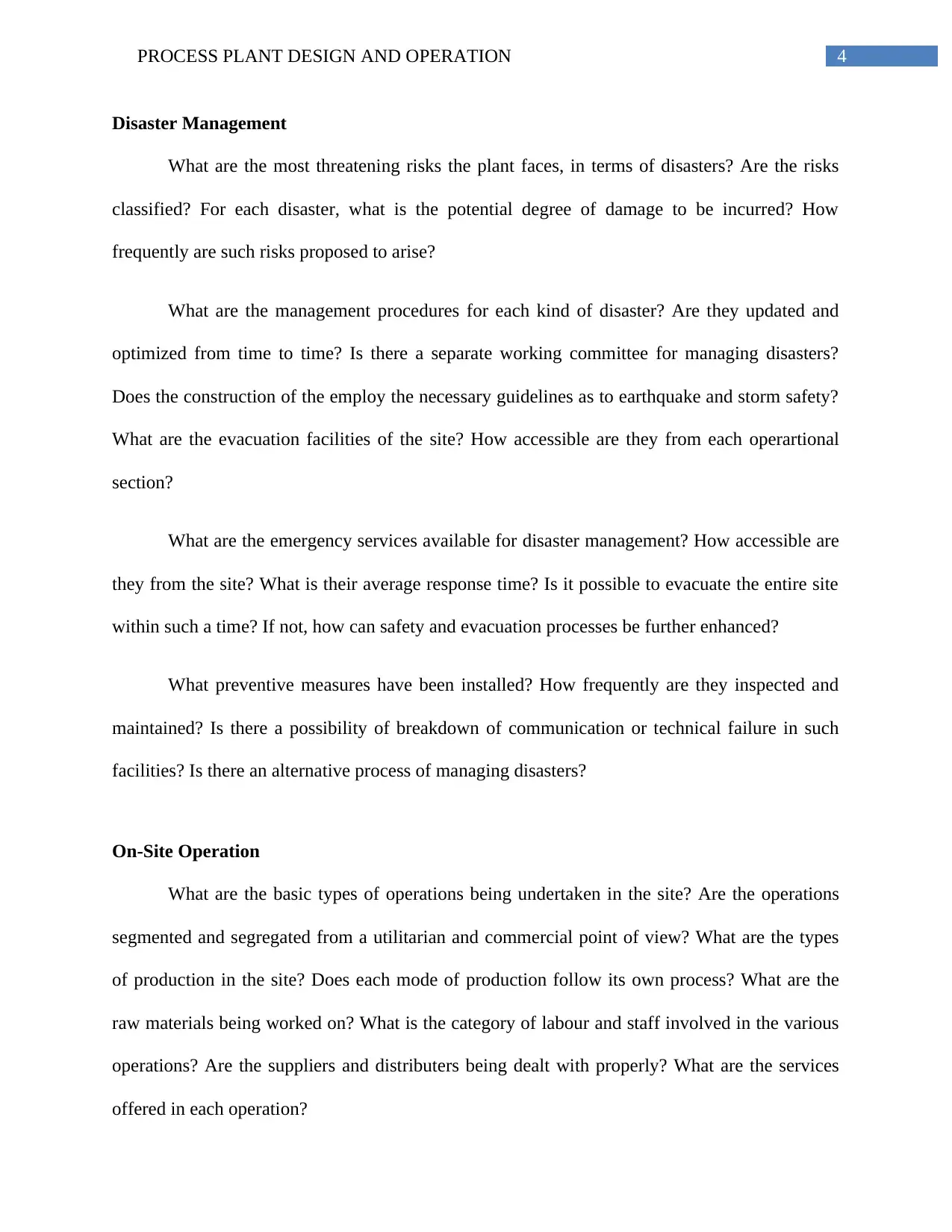
4PROCESS PLANT DESIGN AND OPERATION
Disaster Management
What are the most threatening risks the plant faces, in terms of disasters? Are the risks
classified? For each disaster, what is the potential degree of damage to be incurred? How
frequently are such risks proposed to arise?
What are the management procedures for each kind of disaster? Are they updated and
optimized from time to time? Is there a separate working committee for managing disasters?
Does the construction of the employ the necessary guidelines as to earthquake and storm safety?
What are the evacuation facilities of the site? How accessible are they from each operartional
section?
What are the emergency services available for disaster management? How accessible are
they from the site? What is their average response time? Is it possible to evacuate the entire site
within such a time? If not, how can safety and evacuation processes be further enhanced?
What preventive measures have been installed? How frequently are they inspected and
maintained? Is there a possibility of breakdown of communication or technical failure in such
facilities? Is there an alternative process of managing disasters?
On-Site Operation
What are the basic types of operations being undertaken in the site? Are the operations
segmented and segregated from a utilitarian and commercial point of view? What are the types
of production in the site? Does each mode of production follow its own process? What are the
raw materials being worked on? What is the category of labour and staff involved in the various
operations? Are the suppliers and distributers being dealt with properly? What are the services
offered in each operation?
Disaster Management
What are the most threatening risks the plant faces, in terms of disasters? Are the risks
classified? For each disaster, what is the potential degree of damage to be incurred? How
frequently are such risks proposed to arise?
What are the management procedures for each kind of disaster? Are they updated and
optimized from time to time? Is there a separate working committee for managing disasters?
Does the construction of the employ the necessary guidelines as to earthquake and storm safety?
What are the evacuation facilities of the site? How accessible are they from each operartional
section?
What are the emergency services available for disaster management? How accessible are
they from the site? What is their average response time? Is it possible to evacuate the entire site
within such a time? If not, how can safety and evacuation processes be further enhanced?
What preventive measures have been installed? How frequently are they inspected and
maintained? Is there a possibility of breakdown of communication or technical failure in such
facilities? Is there an alternative process of managing disasters?
On-Site Operation
What are the basic types of operations being undertaken in the site? Are the operations
segmented and segregated from a utilitarian and commercial point of view? What are the types
of production in the site? Does each mode of production follow its own process? What are the
raw materials being worked on? What is the category of labour and staff involved in the various
operations? Are the suppliers and distributers being dealt with properly? What are the services
offered in each operation?
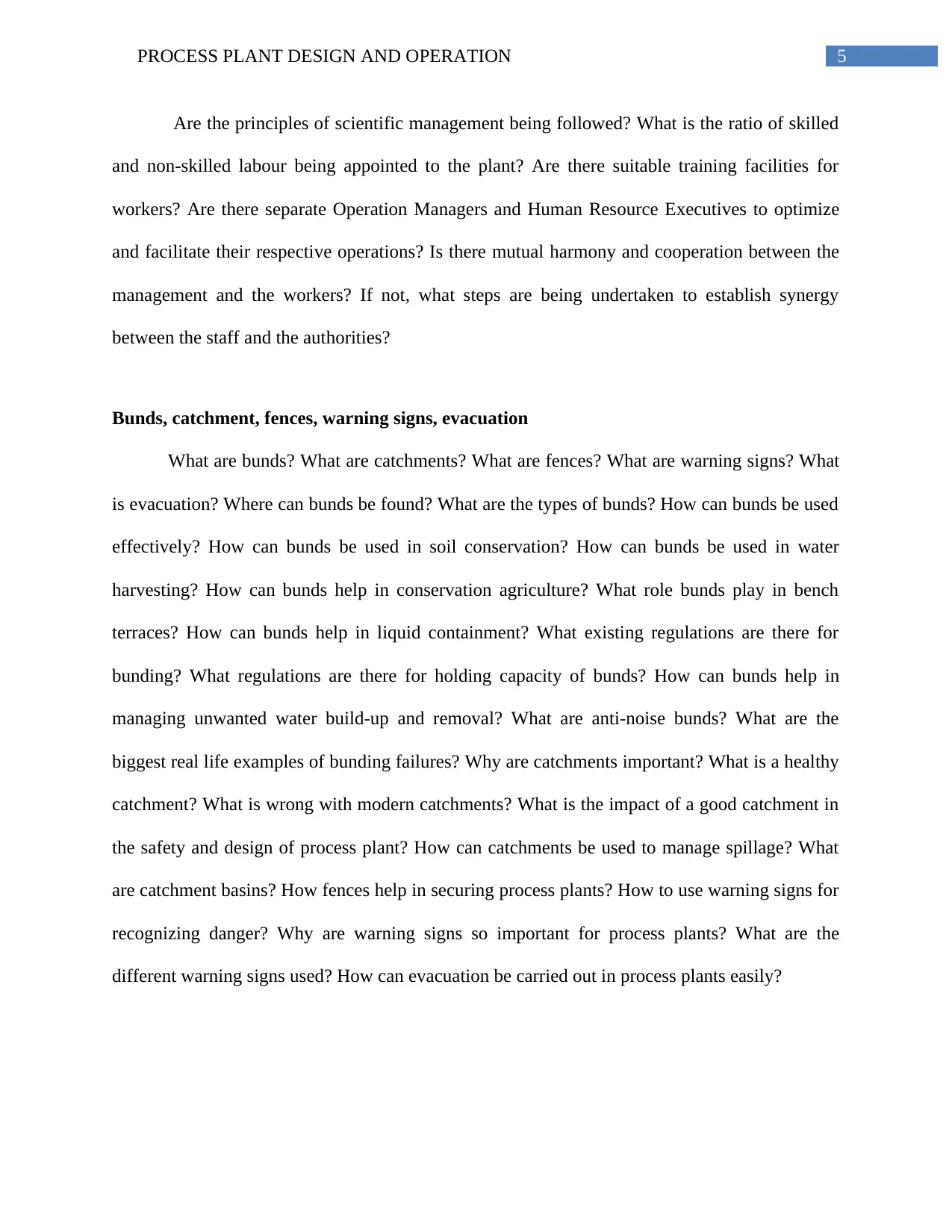
5PROCESS PLANT DESIGN AND OPERATION
Are the principles of scientific management being followed? What is the ratio of skilled
and non-skilled labour being appointed to the plant? Are there suitable training facilities for
workers? Are there separate Operation Managers and Human Resource Executives to optimize
and facilitate their respective operations? Is there mutual harmony and cooperation between the
management and the workers? If not, what steps are being undertaken to establish synergy
between the staff and the authorities?
Bunds, catchment, fences, warning signs, evacuation
What are bunds? What are catchments? What are fences? What are warning signs? What
is evacuation? Where can bunds be found? What are the types of bunds? How can bunds be used
effectively? How can bunds be used in soil conservation? How can bunds be used in water
harvesting? How can bunds help in conservation agriculture? What role bunds play in bench
terraces? How can bunds help in liquid containment? What existing regulations are there for
bunding? What regulations are there for holding capacity of bunds? How can bunds help in
managing unwanted water build-up and removal? What are anti-noise bunds? What are the
biggest real life examples of bunding failures? Why are catchments important? What is a healthy
catchment? What is wrong with modern catchments? What is the impact of a good catchment in
the safety and design of process plant? How can catchments be used to manage spillage? What
are catchment basins? How fences help in securing process plants? How to use warning signs for
recognizing danger? Why are warning signs so important for process plants? What are the
different warning signs used? How can evacuation be carried out in process plants easily?
Are the principles of scientific management being followed? What is the ratio of skilled
and non-skilled labour being appointed to the plant? Are there suitable training facilities for
workers? Are there separate Operation Managers and Human Resource Executives to optimize
and facilitate their respective operations? Is there mutual harmony and cooperation between the
management and the workers? If not, what steps are being undertaken to establish synergy
between the staff and the authorities?
Bunds, catchment, fences, warning signs, evacuation
What are bunds? What are catchments? What are fences? What are warning signs? What
is evacuation? Where can bunds be found? What are the types of bunds? How can bunds be used
effectively? How can bunds be used in soil conservation? How can bunds be used in water
harvesting? How can bunds help in conservation agriculture? What role bunds play in bench
terraces? How can bunds help in liquid containment? What existing regulations are there for
bunding? What regulations are there for holding capacity of bunds? How can bunds help in
managing unwanted water build-up and removal? What are anti-noise bunds? What are the
biggest real life examples of bunding failures? Why are catchments important? What is a healthy
catchment? What is wrong with modern catchments? What is the impact of a good catchment in
the safety and design of process plant? How can catchments be used to manage spillage? What
are catchment basins? How fences help in securing process plants? How to use warning signs for
recognizing danger? Why are warning signs so important for process plants? What are the
different warning signs used? How can evacuation be carried out in process plants easily?
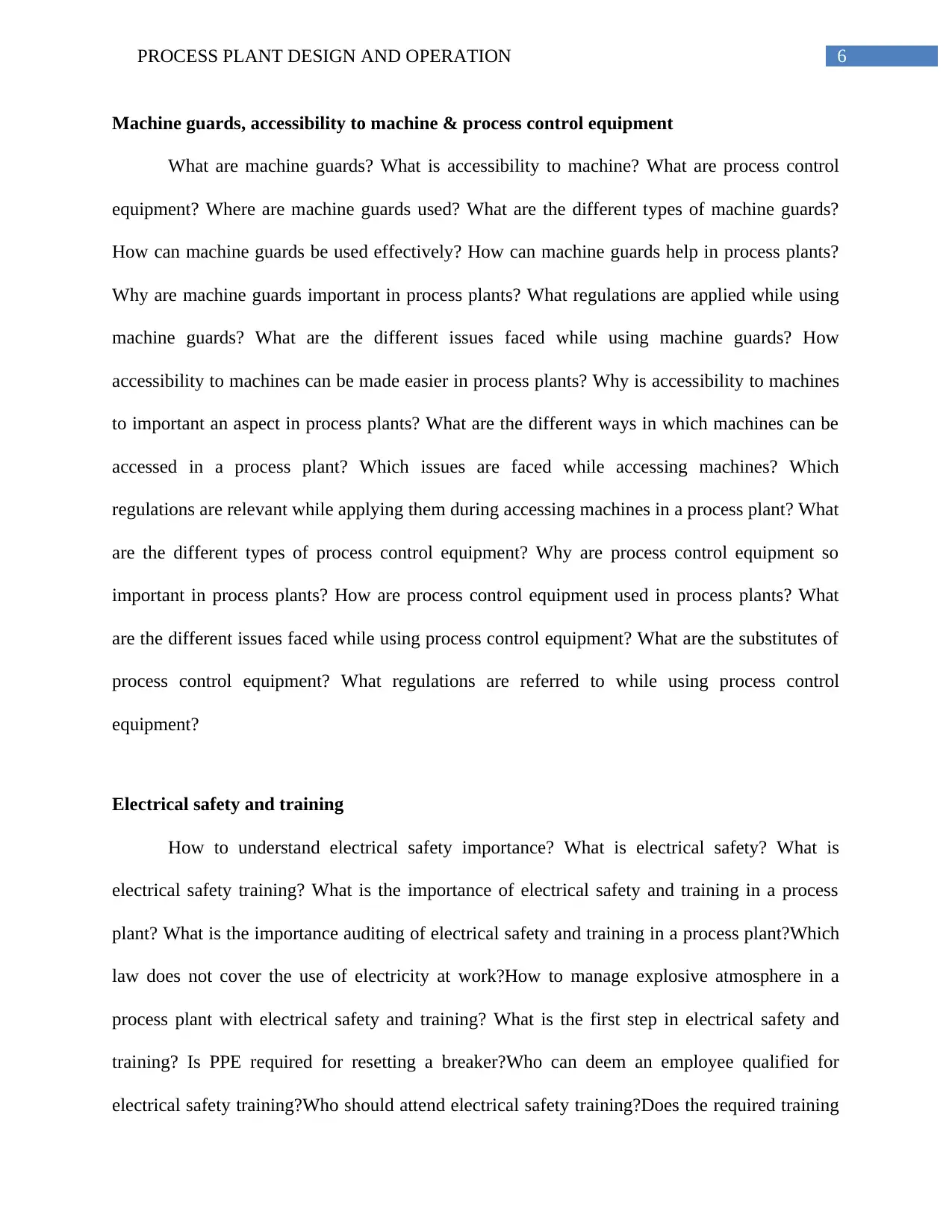
6PROCESS PLANT DESIGN AND OPERATION
Machine guards, accessibility to machine & process control equipment
What are machine guards? What is accessibility to machine? What are process control
equipment? Where are machine guards used? What are the different types of machine guards?
How can machine guards be used effectively? How can machine guards help in process plants?
Why are machine guards important in process plants? What regulations are applied while using
machine guards? What are the different issues faced while using machine guards? How
accessibility to machines can be made easier in process plants? Why is accessibility to machines
to important an aspect in process plants? What are the different ways in which machines can be
accessed in a process plant? Which issues are faced while accessing machines? Which
regulations are relevant while applying them during accessing machines in a process plant? What
are the different types of process control equipment? Why are process control equipment so
important in process plants? How are process control equipment used in process plants? What
are the different issues faced while using process control equipment? What are the substitutes of
process control equipment? What regulations are referred to while using process control
equipment?
Electrical safety and training
How to understand electrical safety importance? What is electrical safety? What is
electrical safety training? What is the importance of electrical safety and training in a process
plant? What is the importance auditing of electrical safety and training in a process plant?Which
law does not cover the use of electricity at work?How to manage explosive atmosphere in a
process plant with electrical safety and training? What is the first step in electrical safety and
training? Is PPE required for resetting a breaker?Who can deem an employee qualified for
electrical safety training?Who should attend electrical safety training?Does the required training
Machine guards, accessibility to machine & process control equipment
What are machine guards? What is accessibility to machine? What are process control
equipment? Where are machine guards used? What are the different types of machine guards?
How can machine guards be used effectively? How can machine guards help in process plants?
Why are machine guards important in process plants? What regulations are applied while using
machine guards? What are the different issues faced while using machine guards? How
accessibility to machines can be made easier in process plants? Why is accessibility to machines
to important an aspect in process plants? What are the different ways in which machines can be
accessed in a process plant? Which issues are faced while accessing machines? Which
regulations are relevant while applying them during accessing machines in a process plant? What
are the different types of process control equipment? Why are process control equipment so
important in process plants? How are process control equipment used in process plants? What
are the different issues faced while using process control equipment? What are the substitutes of
process control equipment? What regulations are referred to while using process control
equipment?
Electrical safety and training
How to understand electrical safety importance? What is electrical safety? What is
electrical safety training? What is the importance of electrical safety and training in a process
plant? What is the importance auditing of electrical safety and training in a process plant?Which
law does not cover the use of electricity at work?How to manage explosive atmosphere in a
process plant with electrical safety and training? What is the first step in electrical safety and
training? Is PPE required for resetting a breaker?Who can deem an employee qualified for
electrical safety training?Who should attend electrical safety training?Does the required training
Paraphrase This Document
Need a fresh take? Get an instant paraphrase of this document with our AI Paraphraser
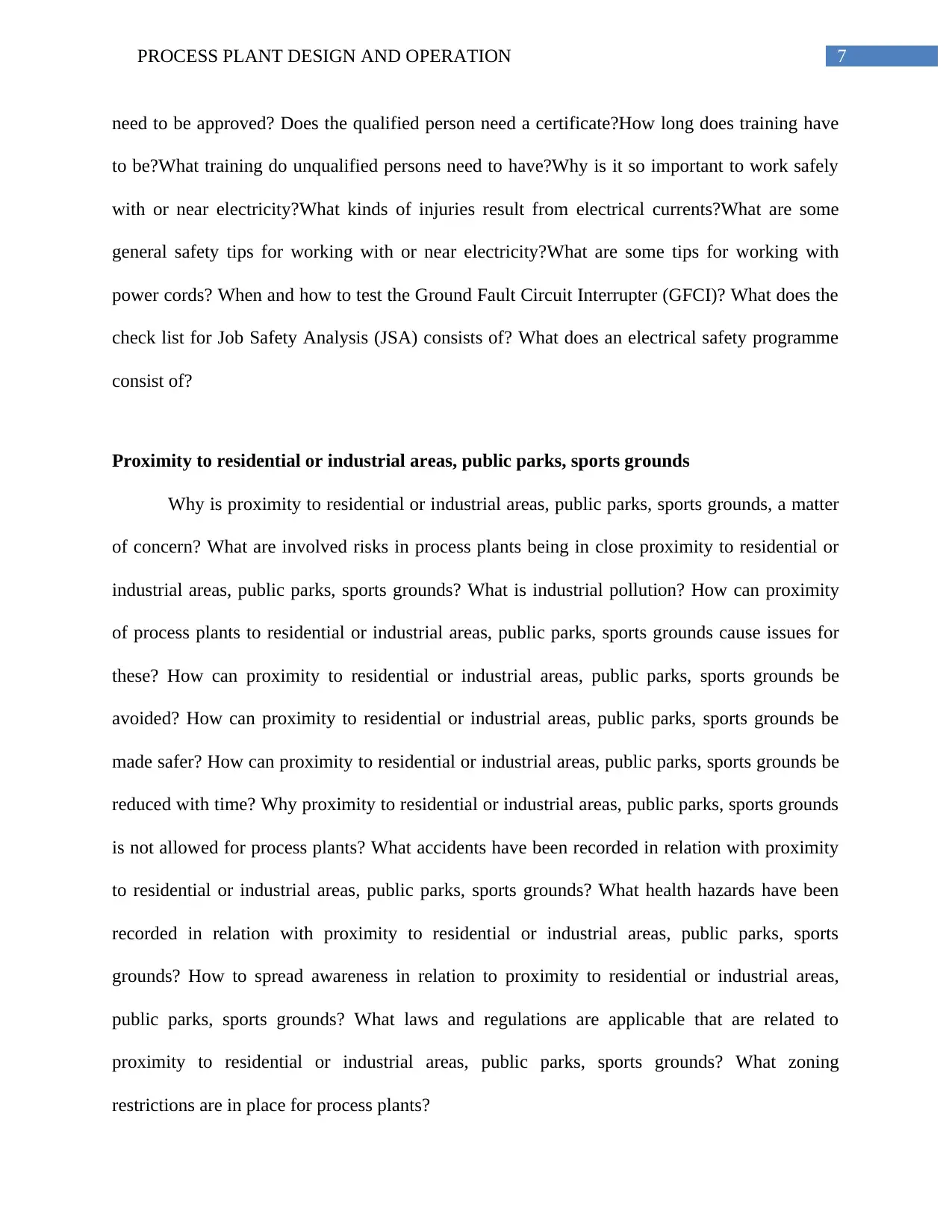
7PROCESS PLANT DESIGN AND OPERATION
need to be approved? Does the qualified person need a certificate?How long does training have
to be?What training do unqualified persons need to have?Why is it so important to work safely
with or near electricity?What kinds of injuries result from electrical currents?What are some
general safety tips for working with or near electricity?What are some tips for working with
power cords? When and how to test the Ground Fault Circuit Interrupter (GFCI)? What does the
check list for Job Safety Analysis (JSA) consists of? What does an electrical safety programme
consist of?
Proximity to residential or industrial areas, public parks, sports grounds
Why is proximity to residential or industrial areas, public parks, sports grounds, a matter
of concern? What are involved risks in process plants being in close proximity to residential or
industrial areas, public parks, sports grounds? What is industrial pollution? How can proximity
of process plants to residential or industrial areas, public parks, sports grounds cause issues for
these? How can proximity to residential or industrial areas, public parks, sports grounds be
avoided? How can proximity to residential or industrial areas, public parks, sports grounds be
made safer? How can proximity to residential or industrial areas, public parks, sports grounds be
reduced with time? Why proximity to residential or industrial areas, public parks, sports grounds
is not allowed for process plants? What accidents have been recorded in relation with proximity
to residential or industrial areas, public parks, sports grounds? What health hazards have been
recorded in relation with proximity to residential or industrial areas, public parks, sports
grounds? How to spread awareness in relation to proximity to residential or industrial areas,
public parks, sports grounds? What laws and regulations are applicable that are related to
proximity to residential or industrial areas, public parks, sports grounds? What zoning
restrictions are in place for process plants?
need to be approved? Does the qualified person need a certificate?How long does training have
to be?What training do unqualified persons need to have?Why is it so important to work safely
with or near electricity?What kinds of injuries result from electrical currents?What are some
general safety tips for working with or near electricity?What are some tips for working with
power cords? When and how to test the Ground Fault Circuit Interrupter (GFCI)? What does the
check list for Job Safety Analysis (JSA) consists of? What does an electrical safety programme
consist of?
Proximity to residential or industrial areas, public parks, sports grounds
Why is proximity to residential or industrial areas, public parks, sports grounds, a matter
of concern? What are involved risks in process plants being in close proximity to residential or
industrial areas, public parks, sports grounds? What is industrial pollution? How can proximity
of process plants to residential or industrial areas, public parks, sports grounds cause issues for
these? How can proximity to residential or industrial areas, public parks, sports grounds be
avoided? How can proximity to residential or industrial areas, public parks, sports grounds be
made safer? How can proximity to residential or industrial areas, public parks, sports grounds be
reduced with time? Why proximity to residential or industrial areas, public parks, sports grounds
is not allowed for process plants? What accidents have been recorded in relation with proximity
to residential or industrial areas, public parks, sports grounds? What health hazards have been
recorded in relation with proximity to residential or industrial areas, public parks, sports
grounds? How to spread awareness in relation to proximity to residential or industrial areas,
public parks, sports grounds? What laws and regulations are applicable that are related to
proximity to residential or industrial areas, public parks, sports grounds? What zoning
restrictions are in place for process plants?
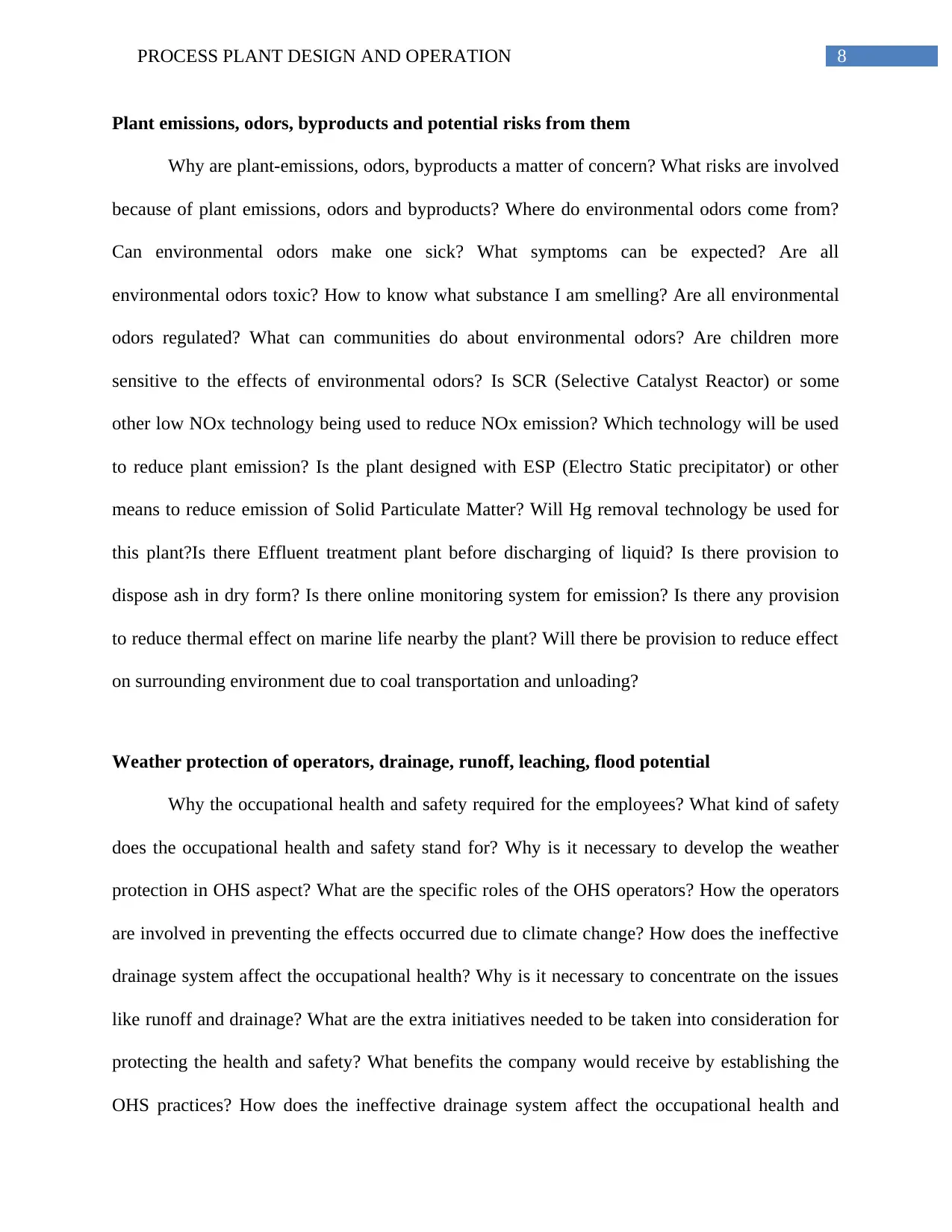
8PROCESS PLANT DESIGN AND OPERATION
Plant emissions, odors, byproducts and potential risks from them
Why are plant-emissions, odors, byproducts a matter of concern? What risks are involved
because of plant emissions, odors and byproducts? Where do environmental odors come from?
Can environmental odors make one sick? What symptoms can be expected? Are all
environmental odors toxic? How to know what substance I am smelling? Are all environmental
odors regulated? What can communities do about environmental odors? Are children more
sensitive to the effects of environmental odors? Is SCR (Selective Catalyst Reactor) or some
other low NOx technology being used to reduce NOx emission? Which technology will be used
to reduce plant emission? Is the plant designed with ESP (Electro Static precipitator) or other
means to reduce emission of Solid Particulate Matter? Will Hg removal technology be used for
this plant?Is there Effluent treatment plant before discharging of liquid? Is there provision to
dispose ash in dry form? Is there online monitoring system for emission? Is there any provision
to reduce thermal effect on marine life nearby the plant? Will there be provision to reduce effect
on surrounding environment due to coal transportation and unloading?
Weather protection of operators, drainage, runoff, leaching, flood potential
Why the occupational health and safety required for the employees? What kind of safety
does the occupational health and safety stand for? Why is it necessary to develop the weather
protection in OHS aspect? What are the specific roles of the OHS operators? How the operators
are involved in preventing the effects occurred due to climate change? How does the ineffective
drainage system affect the occupational health? Why is it necessary to concentrate on the issues
like runoff and drainage? What are the extra initiatives needed to be taken into consideration for
protecting the health and safety? What benefits the company would receive by establishing the
OHS practices? How does the ineffective drainage system affect the occupational health and
Plant emissions, odors, byproducts and potential risks from them
Why are plant-emissions, odors, byproducts a matter of concern? What risks are involved
because of plant emissions, odors and byproducts? Where do environmental odors come from?
Can environmental odors make one sick? What symptoms can be expected? Are all
environmental odors toxic? How to know what substance I am smelling? Are all environmental
odors regulated? What can communities do about environmental odors? Are children more
sensitive to the effects of environmental odors? Is SCR (Selective Catalyst Reactor) or some
other low NOx technology being used to reduce NOx emission? Which technology will be used
to reduce plant emission? Is the plant designed with ESP (Electro Static precipitator) or other
means to reduce emission of Solid Particulate Matter? Will Hg removal technology be used for
this plant?Is there Effluent treatment plant before discharging of liquid? Is there provision to
dispose ash in dry form? Is there online monitoring system for emission? Is there any provision
to reduce thermal effect on marine life nearby the plant? Will there be provision to reduce effect
on surrounding environment due to coal transportation and unloading?
Weather protection of operators, drainage, runoff, leaching, flood potential
Why the occupational health and safety required for the employees? What kind of safety
does the occupational health and safety stand for? Why is it necessary to develop the weather
protection in OHS aspect? What are the specific roles of the OHS operators? How the operators
are involved in preventing the effects occurred due to climate change? How does the ineffective
drainage system affect the occupational health? Why is it necessary to concentrate on the issues
like runoff and drainage? What are the extra initiatives needed to be taken into consideration for
protecting the health and safety? What benefits the company would receive by establishing the
OHS practices? How does the ineffective drainage system affect the occupational health and
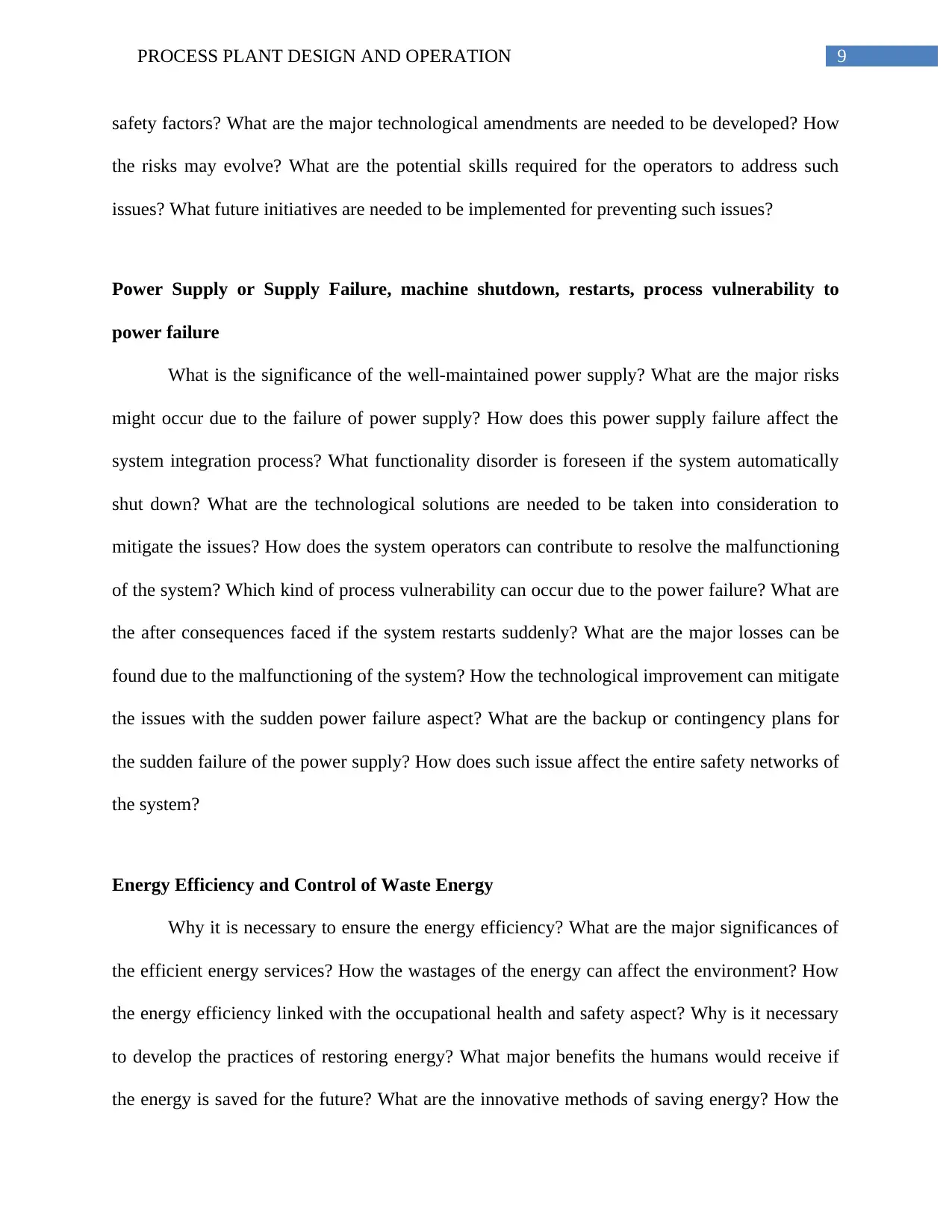
9PROCESS PLANT DESIGN AND OPERATION
safety factors? What are the major technological amendments are needed to be developed? How
the risks may evolve? What are the potential skills required for the operators to address such
issues? What future initiatives are needed to be implemented for preventing such issues?
Power Supply or Supply Failure, machine shutdown, restarts, process vulnerability to
power failure
What is the significance of the well-maintained power supply? What are the major risks
might occur due to the failure of power supply? How does this power supply failure affect the
system integration process? What functionality disorder is foreseen if the system automatically
shut down? What are the technological solutions are needed to be taken into consideration to
mitigate the issues? How does the system operators can contribute to resolve the malfunctioning
of the system? Which kind of process vulnerability can occur due to the power failure? What are
the after consequences faced if the system restarts suddenly? What are the major losses can be
found due to the malfunctioning of the system? How the technological improvement can mitigate
the issues with the sudden power failure aspect? What are the backup or contingency plans for
the sudden failure of the power supply? How does such issue affect the entire safety networks of
the system?
Energy Efficiency and Control of Waste Energy
Why it is necessary to ensure the energy efficiency? What are the major significances of
the efficient energy services? How the wastages of the energy can affect the environment? How
the energy efficiency linked with the occupational health and safety aspect? Why is it necessary
to develop the practices of restoring energy? What major benefits the humans would receive if
the energy is saved for the future? What are the innovative methods of saving energy? How the
safety factors? What are the major technological amendments are needed to be developed? How
the risks may evolve? What are the potential skills required for the operators to address such
issues? What future initiatives are needed to be implemented for preventing such issues?
Power Supply or Supply Failure, machine shutdown, restarts, process vulnerability to
power failure
What is the significance of the well-maintained power supply? What are the major risks
might occur due to the failure of power supply? How does this power supply failure affect the
system integration process? What functionality disorder is foreseen if the system automatically
shut down? What are the technological solutions are needed to be taken into consideration to
mitigate the issues? How does the system operators can contribute to resolve the malfunctioning
of the system? Which kind of process vulnerability can occur due to the power failure? What are
the after consequences faced if the system restarts suddenly? What are the major losses can be
found due to the malfunctioning of the system? How the technological improvement can mitigate
the issues with the sudden power failure aspect? What are the backup or contingency plans for
the sudden failure of the power supply? How does such issue affect the entire safety networks of
the system?
Energy Efficiency and Control of Waste Energy
Why it is necessary to ensure the energy efficiency? What are the major significances of
the efficient energy services? How the wastages of the energy can affect the environment? How
the energy efficiency linked with the occupational health and safety aspect? Why is it necessary
to develop the practices of restoring energy? What major benefits the humans would receive if
the energy is saved for the future? What are the innovative methods of saving energy? How the
Secure Best Marks with AI Grader
Need help grading? Try our AI Grader for instant feedback on your assignments.
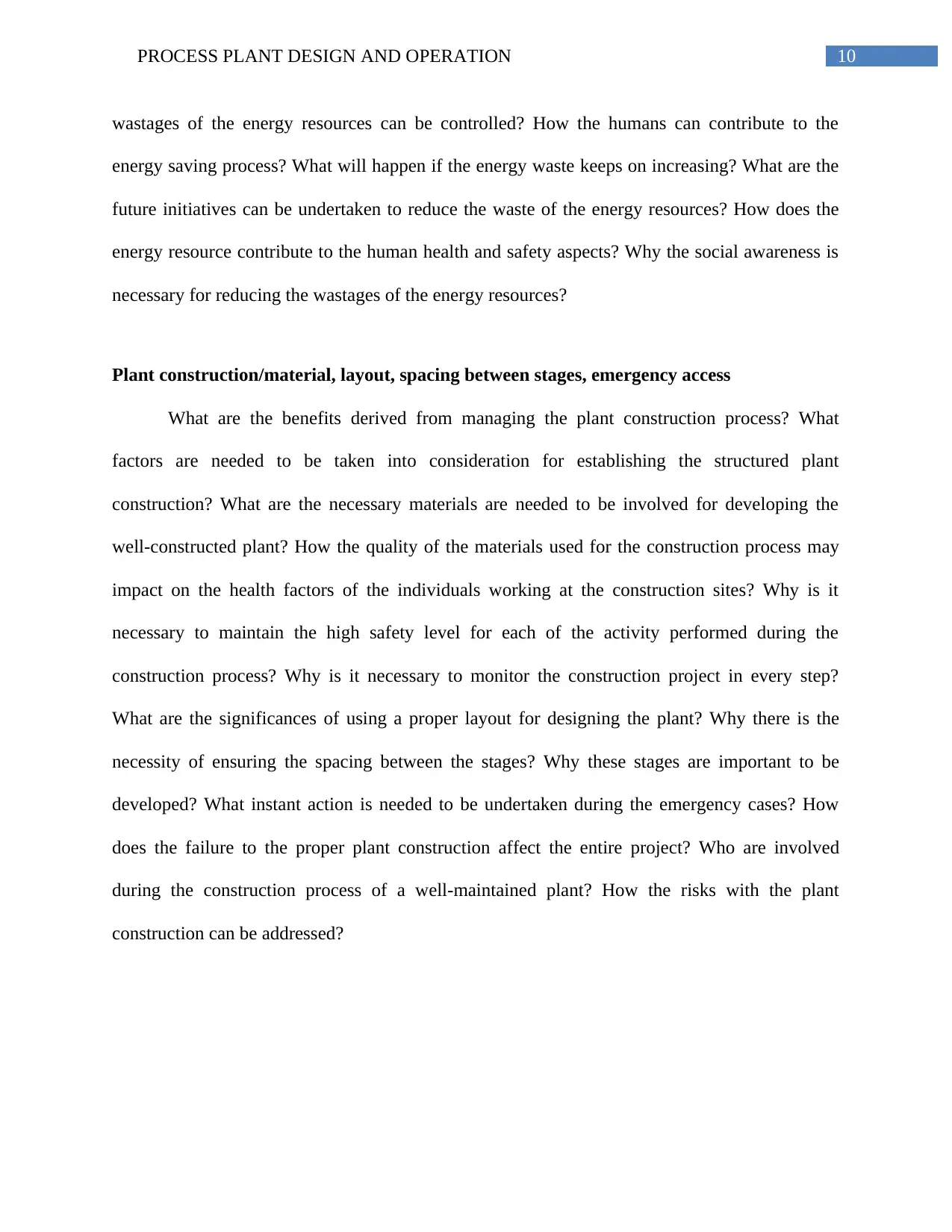
10PROCESS PLANT DESIGN AND OPERATION
wastages of the energy resources can be controlled? How the humans can contribute to the
energy saving process? What will happen if the energy waste keeps on increasing? What are the
future initiatives can be undertaken to reduce the waste of the energy resources? How does the
energy resource contribute to the human health and safety aspects? Why the social awareness is
necessary for reducing the wastages of the energy resources?
Plant construction/material, layout, spacing between stages, emergency access
What are the benefits derived from managing the plant construction process? What
factors are needed to be taken into consideration for establishing the structured plant
construction? What are the necessary materials are needed to be involved for developing the
well-constructed plant? How the quality of the materials used for the construction process may
impact on the health factors of the individuals working at the construction sites? Why is it
necessary to maintain the high safety level for each of the activity performed during the
construction process? Why is it necessary to monitor the construction project in every step?
What are the significances of using a proper layout for designing the plant? Why there is the
necessity of ensuring the spacing between the stages? Why these stages are important to be
developed? What instant action is needed to be undertaken during the emergency cases? How
does the failure to the proper plant construction affect the entire project? Who are involved
during the construction process of a well-maintained plant? How the risks with the plant
construction can be addressed?
wastages of the energy resources can be controlled? How the humans can contribute to the
energy saving process? What will happen if the energy waste keeps on increasing? What are the
future initiatives can be undertaken to reduce the waste of the energy resources? How does the
energy resource contribute to the human health and safety aspects? Why the social awareness is
necessary for reducing the wastages of the energy resources?
Plant construction/material, layout, spacing between stages, emergency access
What are the benefits derived from managing the plant construction process? What
factors are needed to be taken into consideration for establishing the structured plant
construction? What are the necessary materials are needed to be involved for developing the
well-constructed plant? How the quality of the materials used for the construction process may
impact on the health factors of the individuals working at the construction sites? Why is it
necessary to maintain the high safety level for each of the activity performed during the
construction process? Why is it necessary to monitor the construction project in every step?
What are the significances of using a proper layout for designing the plant? Why there is the
necessity of ensuring the spacing between the stages? Why these stages are important to be
developed? What instant action is needed to be undertaken during the emergency cases? How
does the failure to the proper plant construction affect the entire project? Who are involved
during the construction process of a well-maintained plant? How the risks with the plant
construction can be addressed?
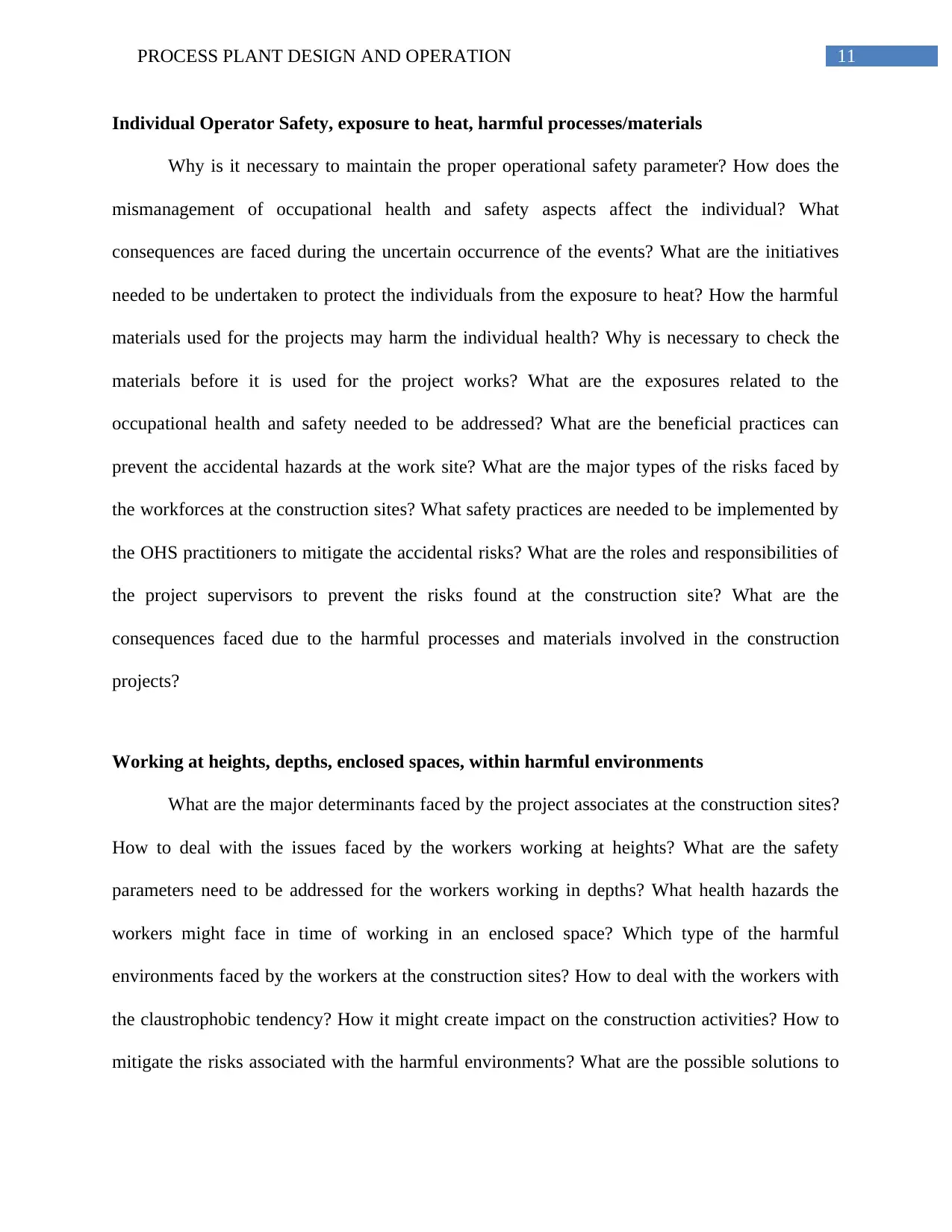
11PROCESS PLANT DESIGN AND OPERATION
Individual Operator Safety, exposure to heat, harmful processes/materials
Why is it necessary to maintain the proper operational safety parameter? How does the
mismanagement of occupational health and safety aspects affect the individual? What
consequences are faced during the uncertain occurrence of the events? What are the initiatives
needed to be undertaken to protect the individuals from the exposure to heat? How the harmful
materials used for the projects may harm the individual health? Why is necessary to check the
materials before it is used for the project works? What are the exposures related to the
occupational health and safety needed to be addressed? What are the beneficial practices can
prevent the accidental hazards at the work site? What are the major types of the risks faced by
the workforces at the construction sites? What safety practices are needed to be implemented by
the OHS practitioners to mitigate the accidental risks? What are the roles and responsibilities of
the project supervisors to prevent the risks found at the construction site? What are the
consequences faced due to the harmful processes and materials involved in the construction
projects?
Working at heights, depths, enclosed spaces, within harmful environments
What are the major determinants faced by the project associates at the construction sites?
How to deal with the issues faced by the workers working at heights? What are the safety
parameters need to be addressed for the workers working in depths? What health hazards the
workers might face in time of working in an enclosed space? Which type of the harmful
environments faced by the workers at the construction sites? How to deal with the workers with
the claustrophobic tendency? How it might create impact on the construction activities? How to
mitigate the risks associated with the harmful environments? What are the possible solutions to
Individual Operator Safety, exposure to heat, harmful processes/materials
Why is it necessary to maintain the proper operational safety parameter? How does the
mismanagement of occupational health and safety aspects affect the individual? What
consequences are faced during the uncertain occurrence of the events? What are the initiatives
needed to be undertaken to protect the individuals from the exposure to heat? How the harmful
materials used for the projects may harm the individual health? Why is necessary to check the
materials before it is used for the project works? What are the exposures related to the
occupational health and safety needed to be addressed? What are the beneficial practices can
prevent the accidental hazards at the work site? What are the major types of the risks faced by
the workforces at the construction sites? What safety practices are needed to be implemented by
the OHS practitioners to mitigate the accidental risks? What are the roles and responsibilities of
the project supervisors to prevent the risks found at the construction site? What are the
consequences faced due to the harmful processes and materials involved in the construction
projects?
Working at heights, depths, enclosed spaces, within harmful environments
What are the major determinants faced by the project associates at the construction sites?
How to deal with the issues faced by the workers working at heights? What are the safety
parameters need to be addressed for the workers working in depths? What health hazards the
workers might face in time of working in an enclosed space? Which type of the harmful
environments faced by the workers at the construction sites? How to deal with the workers with
the claustrophobic tendency? How it might create impact on the construction activities? How to
mitigate the risks associated with the harmful environments? What are the possible solutions to
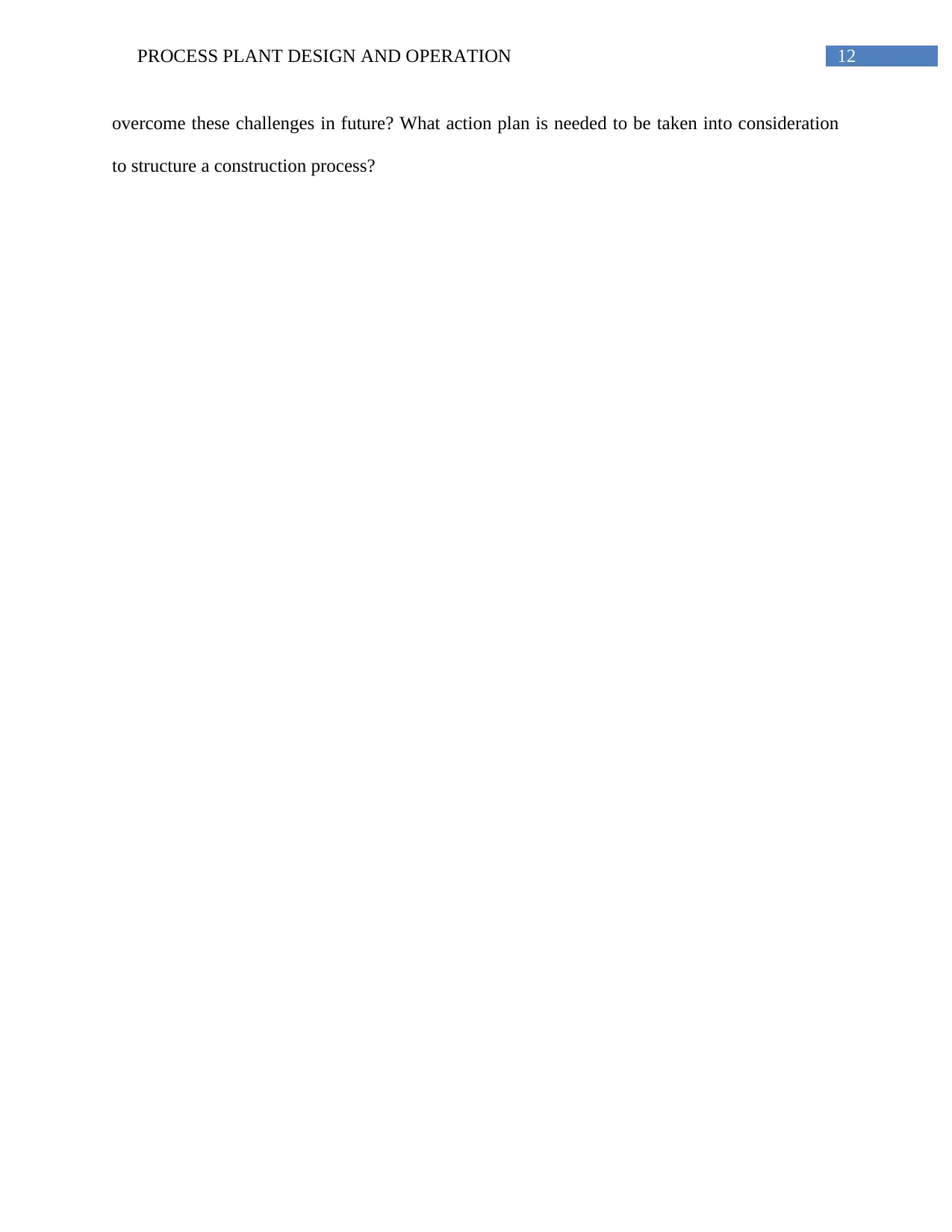
12PROCESS PLANT DESIGN AND OPERATION
overcome these challenges in future? What action plan is needed to be taken into consideration
to structure a construction process?
overcome these challenges in future? What action plan is needed to be taken into consideration
to structure a construction process?
Paraphrase This Document
Need a fresh take? Get an instant paraphrase of this document with our AI Paraphraser
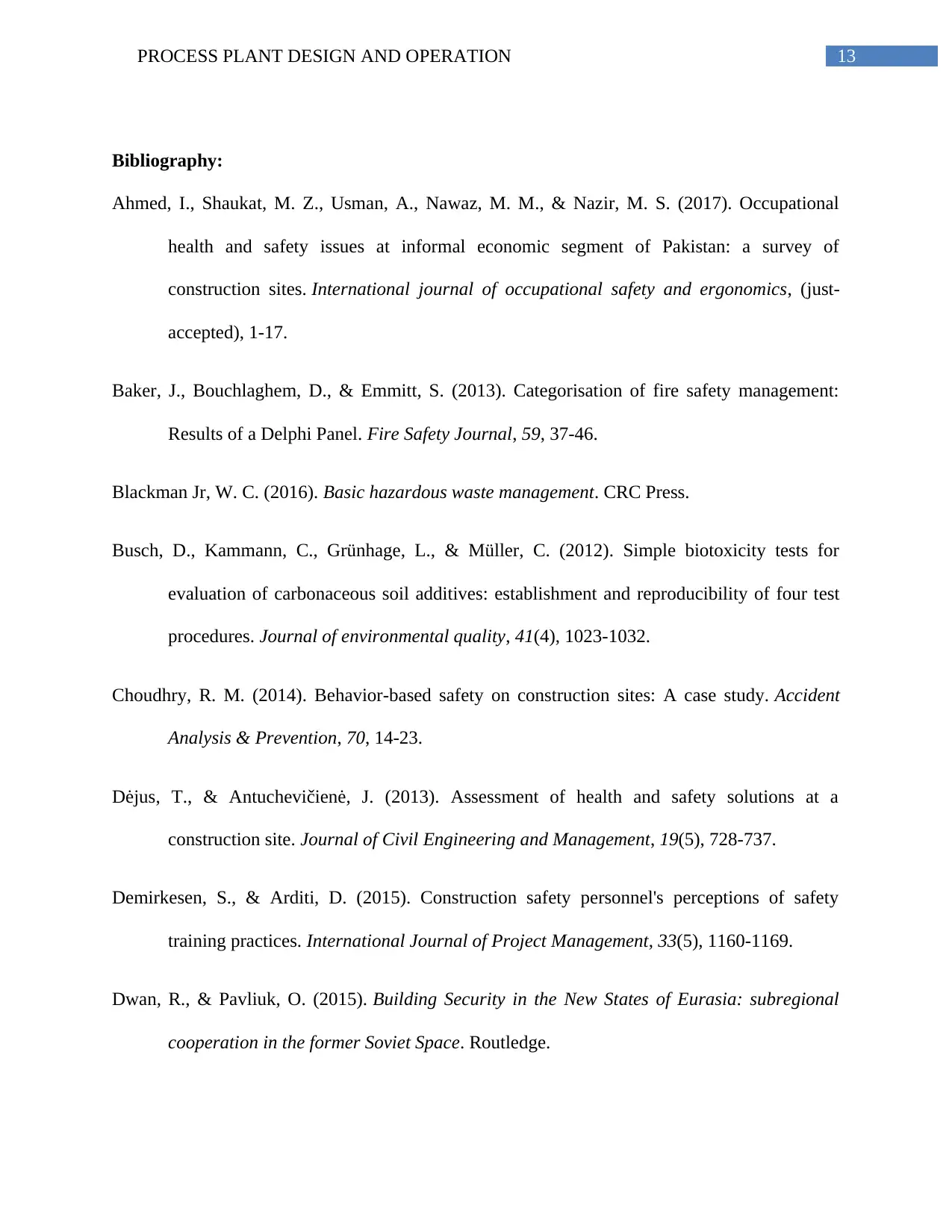
13PROCESS PLANT DESIGN AND OPERATION
Bibliography:
Ahmed, I., Shaukat, M. Z., Usman, A., Nawaz, M. M., & Nazir, M. S. (2017). Occupational
health and safety issues at informal economic segment of Pakistan: a survey of
construction sites. International journal of occupational safety and ergonomics, (just-
accepted), 1-17.
Baker, J., Bouchlaghem, D., & Emmitt, S. (2013). Categorisation of fire safety management:
Results of a Delphi Panel. Fire Safety Journal, 59, 37-46.
Blackman Jr, W. C. (2016). Basic hazardous waste management. CRC Press.
Busch, D., Kammann, C., Grünhage, L., & Müller, C. (2012). Simple biotoxicity tests for
evaluation of carbonaceous soil additives: establishment and reproducibility of four test
procedures. Journal of environmental quality, 41(4), 1023-1032.
Choudhry, R. M. (2014). Behavior-based safety on construction sites: A case study. Accident
Analysis & Prevention, 70, 14-23.
Dėjus, T., & Antuchevičienė, J. (2013). Assessment of health and safety solutions at a
construction site. Journal of Civil Engineering and Management, 19(5), 728-737.
Demirkesen, S., & Arditi, D. (2015). Construction safety personnel's perceptions of safety
training practices. International Journal of Project Management, 33(5), 1160-1169.
Dwan, R., & Pavliuk, O. (2015). Building Security in the New States of Eurasia: subregional
cooperation in the former Soviet Space. Routledge.
Bibliography:
Ahmed, I., Shaukat, M. Z., Usman, A., Nawaz, M. M., & Nazir, M. S. (2017). Occupational
health and safety issues at informal economic segment of Pakistan: a survey of
construction sites. International journal of occupational safety and ergonomics, (just-
accepted), 1-17.
Baker, J., Bouchlaghem, D., & Emmitt, S. (2013). Categorisation of fire safety management:
Results of a Delphi Panel. Fire Safety Journal, 59, 37-46.
Blackman Jr, W. C. (2016). Basic hazardous waste management. CRC Press.
Busch, D., Kammann, C., Grünhage, L., & Müller, C. (2012). Simple biotoxicity tests for
evaluation of carbonaceous soil additives: establishment and reproducibility of four test
procedures. Journal of environmental quality, 41(4), 1023-1032.
Choudhry, R. M. (2014). Behavior-based safety on construction sites: A case study. Accident
Analysis & Prevention, 70, 14-23.
Dėjus, T., & Antuchevičienė, J. (2013). Assessment of health and safety solutions at a
construction site. Journal of Civil Engineering and Management, 19(5), 728-737.
Demirkesen, S., & Arditi, D. (2015). Construction safety personnel's perceptions of safety
training practices. International Journal of Project Management, 33(5), 1160-1169.
Dwan, R., & Pavliuk, O. (2015). Building Security in the New States of Eurasia: subregional
cooperation in the former Soviet Space. Routledge.
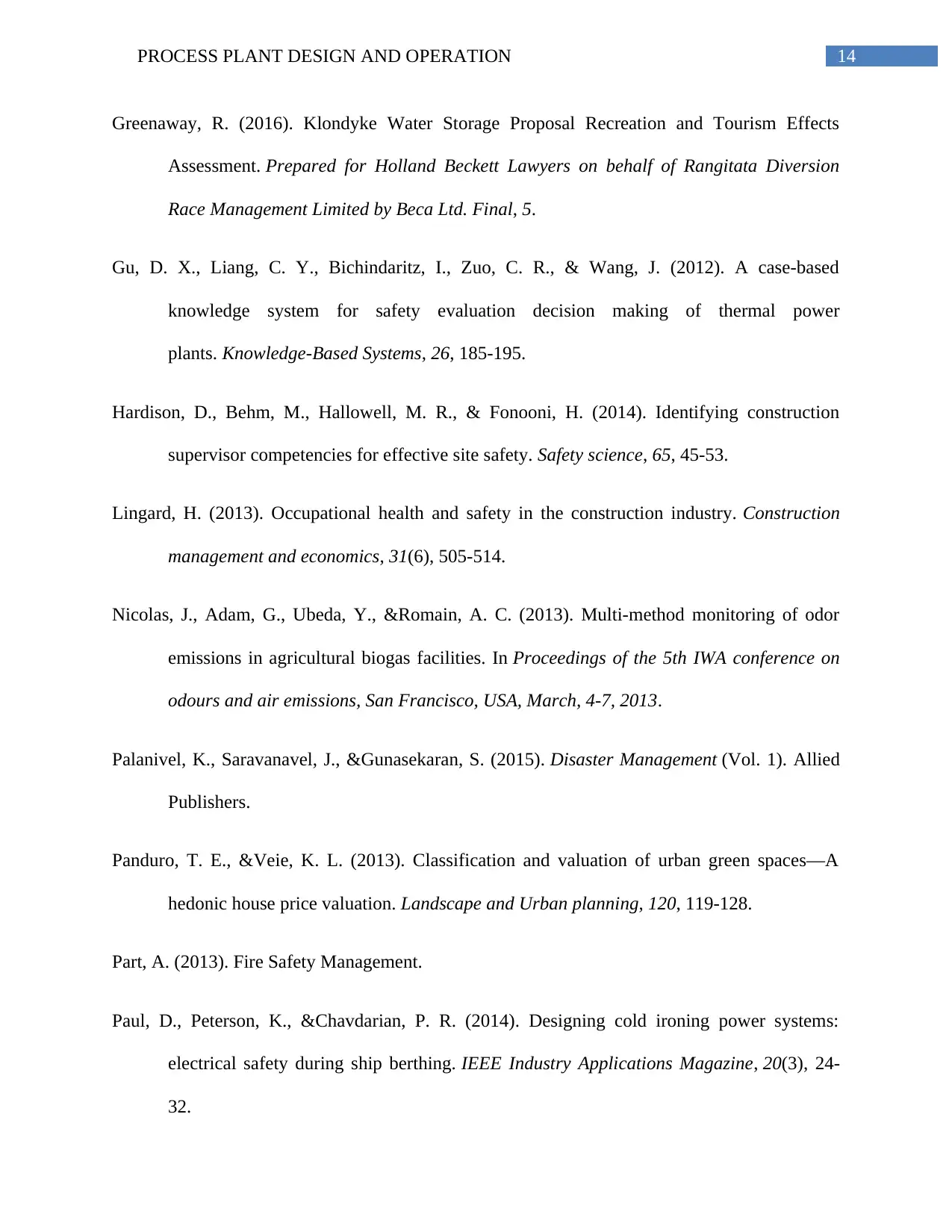
14PROCESS PLANT DESIGN AND OPERATION
Greenaway, R. (2016). Klondyke Water Storage Proposal Recreation and Tourism Effects
Assessment. Prepared for Holland Beckett Lawyers on behalf of Rangitata Diversion
Race Management Limited by Beca Ltd. Final, 5.
Gu, D. X., Liang, C. Y., Bichindaritz, I., Zuo, C. R., & Wang, J. (2012). A case-based
knowledge system for safety evaluation decision making of thermal power
plants. Knowledge-Based Systems, 26, 185-195.
Hardison, D., Behm, M., Hallowell, M. R., & Fonooni, H. (2014). Identifying construction
supervisor competencies for effective site safety. Safety science, 65, 45-53.
Lingard, H. (2013). Occupational health and safety in the construction industry. Construction
management and economics, 31(6), 505-514.
Nicolas, J., Adam, G., Ubeda, Y., &Romain, A. C. (2013). Multi-method monitoring of odor
emissions in agricultural biogas facilities. In Proceedings of the 5th IWA conference on
odours and air emissions, San Francisco, USA, March, 4-7, 2013.
Palanivel, K., Saravanavel, J., &Gunasekaran, S. (2015). Disaster Management (Vol. 1). Allied
Publishers.
Panduro, T. E., &Veie, K. L. (2013). Classification and valuation of urban green spaces—A
hedonic house price valuation. Landscape and Urban planning, 120, 119-128.
Part, A. (2013). Fire Safety Management.
Paul, D., Peterson, K., &Chavdarian, P. R. (2014). Designing cold ironing power systems:
electrical safety during ship berthing. IEEE Industry Applications Magazine, 20(3), 24-
32.
Greenaway, R. (2016). Klondyke Water Storage Proposal Recreation and Tourism Effects
Assessment. Prepared for Holland Beckett Lawyers on behalf of Rangitata Diversion
Race Management Limited by Beca Ltd. Final, 5.
Gu, D. X., Liang, C. Y., Bichindaritz, I., Zuo, C. R., & Wang, J. (2012). A case-based
knowledge system for safety evaluation decision making of thermal power
plants. Knowledge-Based Systems, 26, 185-195.
Hardison, D., Behm, M., Hallowell, M. R., & Fonooni, H. (2014). Identifying construction
supervisor competencies for effective site safety. Safety science, 65, 45-53.
Lingard, H. (2013). Occupational health and safety in the construction industry. Construction
management and economics, 31(6), 505-514.
Nicolas, J., Adam, G., Ubeda, Y., &Romain, A. C. (2013). Multi-method monitoring of odor
emissions in agricultural biogas facilities. In Proceedings of the 5th IWA conference on
odours and air emissions, San Francisco, USA, March, 4-7, 2013.
Palanivel, K., Saravanavel, J., &Gunasekaran, S. (2015). Disaster Management (Vol. 1). Allied
Publishers.
Panduro, T. E., &Veie, K. L. (2013). Classification and valuation of urban green spaces—A
hedonic house price valuation. Landscape and Urban planning, 120, 119-128.
Part, A. (2013). Fire Safety Management.
Paul, D., Peterson, K., &Chavdarian, P. R. (2014). Designing cold ironing power systems:
electrical safety during ship berthing. IEEE Industry Applications Magazine, 20(3), 24-
32.
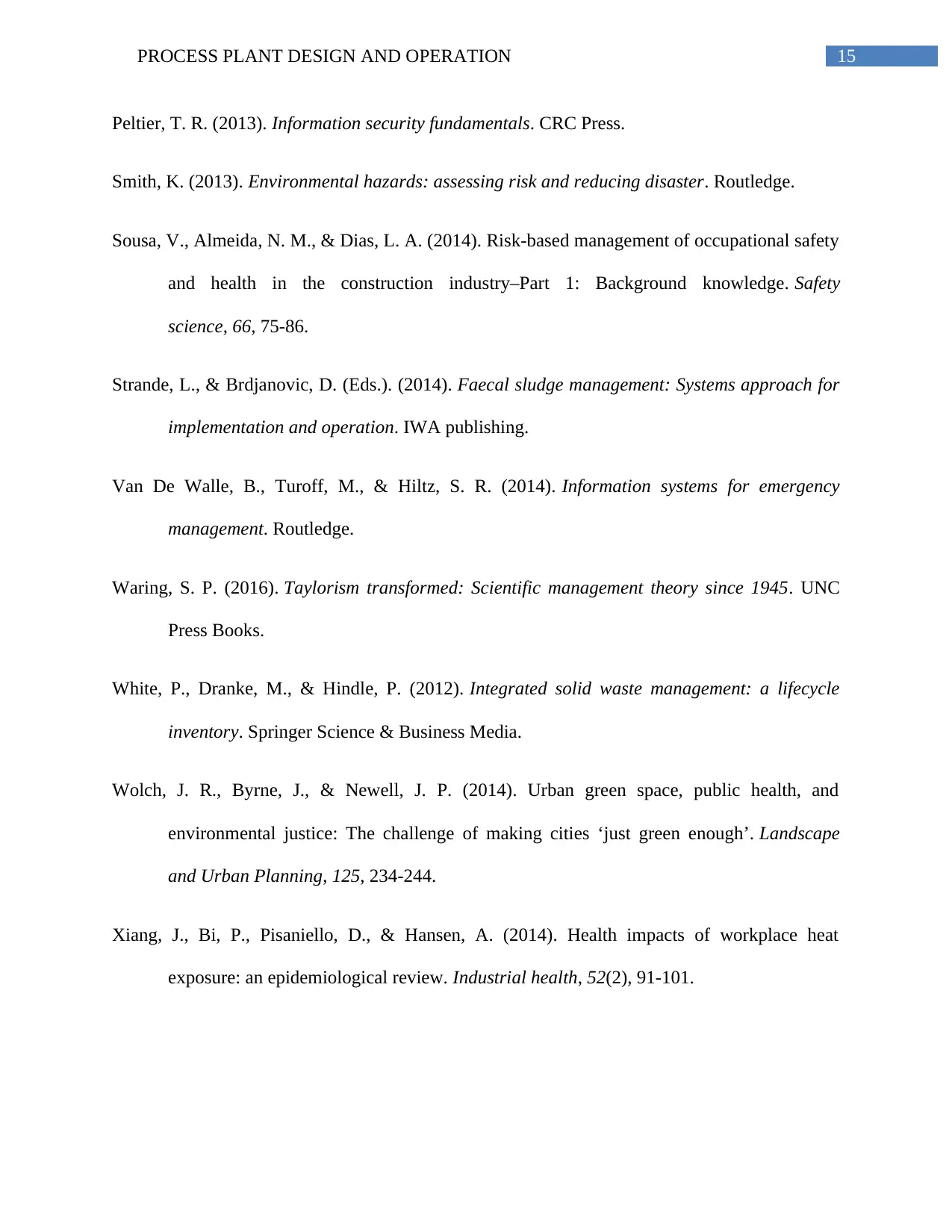
15PROCESS PLANT DESIGN AND OPERATION
Peltier, T. R. (2013). Information security fundamentals. CRC Press.
Smith, K. (2013). Environmental hazards: assessing risk and reducing disaster. Routledge.
Sousa, V., Almeida, N. M., & Dias, L. A. (2014). Risk-based management of occupational safety
and health in the construction industry–Part 1: Background knowledge. Safety
science, 66, 75-86.
Strande, L., & Brdjanovic, D. (Eds.). (2014). Faecal sludge management: Systems approach for
implementation and operation. IWA publishing.
Van De Walle, B., Turoff, M., & Hiltz, S. R. (2014). Information systems for emergency
management. Routledge.
Waring, S. P. (2016). Taylorism transformed: Scientific management theory since 1945. UNC
Press Books.
White, P., Dranke, M., & Hindle, P. (2012). Integrated solid waste management: a lifecycle
inventory. Springer Science & Business Media.
Wolch, J. R., Byrne, J., & Newell, J. P. (2014). Urban green space, public health, and
environmental justice: The challenge of making cities ‘just green enough’. Landscape
and Urban Planning, 125, 234-244.
Xiang, J., Bi, P., Pisaniello, D., & Hansen, A. (2014). Health impacts of workplace heat
exposure: an epidemiological review. Industrial health, 52(2), 91-101.
Peltier, T. R. (2013). Information security fundamentals. CRC Press.
Smith, K. (2013). Environmental hazards: assessing risk and reducing disaster. Routledge.
Sousa, V., Almeida, N. M., & Dias, L. A. (2014). Risk-based management of occupational safety
and health in the construction industry–Part 1: Background knowledge. Safety
science, 66, 75-86.
Strande, L., & Brdjanovic, D. (Eds.). (2014). Faecal sludge management: Systems approach for
implementation and operation. IWA publishing.
Van De Walle, B., Turoff, M., & Hiltz, S. R. (2014). Information systems for emergency
management. Routledge.
Waring, S. P. (2016). Taylorism transformed: Scientific management theory since 1945. UNC
Press Books.
White, P., Dranke, M., & Hindle, P. (2012). Integrated solid waste management: a lifecycle
inventory. Springer Science & Business Media.
Wolch, J. R., Byrne, J., & Newell, J. P. (2014). Urban green space, public health, and
environmental justice: The challenge of making cities ‘just green enough’. Landscape
and Urban Planning, 125, 234-244.
Xiang, J., Bi, P., Pisaniello, D., & Hansen, A. (2014). Health impacts of workplace heat
exposure: an epidemiological review. Industrial health, 52(2), 91-101.
1 out of 16
Your All-in-One AI-Powered Toolkit for Academic Success.
+13062052269
info@desklib.com
Available 24*7 on WhatsApp / Email
![[object Object]](/_next/static/media/star-bottom.7253800d.svg)
Unlock your academic potential
© 2024 | Zucol Services PVT LTD | All rights reserved.


